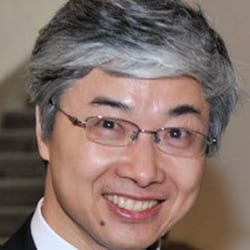Shuguang Zhang

Shuguang Zhang
Competition: US & Canada
Shuguang Zhang is at Center for Bits & Atoms, Massachusetts Institute of Technology. He received his B.S from Sichuan University, China and Ph.D. in biochemistry & molecular biology from University of California at Santa Barbara, USA. He was an American Cancer Society Postdoctoral Fellow and a Whitaker Foundation Investigator at MIT. He was a 2003 Fellow of Japan Society for Promotion of Science (JSPS fellow). His work of designer self-assembling peptide scaffold won 2004 R&D100 award. His and his colleagues’ work for direct harvesting biosolar energy was selected one of the 10 finalists of the 2005 Saatchi & Saatchi Award for World Changing Ideas. He was the winner of the 2006 Wilhelm Exner Medal of Austria. He is a Fellow of American Institute of Medical and Biological Engineering and Fellow of US National Academy of Inventors. He is a Foreign Corresponding Member of Austrian Academy of Sciences. He has so far published over 160 scientific papers relevant to proteins and self-assembling peptides that have been cited over 20,000 times, with a h-index 70. He has 18 issued patents and 20 pending patent applications. He is also a co-founder and board member of Molecular Frontiers Foundation that encourages young people to ask big and good questions in order to win Molecular Frontiers Inquiry Prize.
Shuguang Zhang not only made a serendipitous discovery of the first self-assembling peptide nanomaterials (each peptide is ~6nm with 16 amino acids) in a yeast protein, Zuotin, but he also made seminal contributions to biological engineering and invented several novel biological nanomaterials from self-assembling peptides. He founded a new field: peptide nanomaterials science, namely, the design and fabrication of novel biological nanomaterials at the single amino acid level through molecular self-assembly. Zhang not only discovered the first left-handed Z-DNA binding protein, zuotin in yeast, but he also discovered specific motifs of zuotin in the context of alternating polar and non-polar peptides– the most unusual biological nanomaterials capable of self-assembly, which he termed self-assembling peptides. Zhang then demonstrated that the designer self-assembling peptide nanofiber materials are very useful for: 1) 3-D cell cultures, 2) tissue engineering, 3) regenerative medicine, 4) sustained molecular releases, 5) accelerated wound healing and 6) human surgeries. In order to spread the new nanomaterials, Zhang in 1990s provided free peptide nanomaterials worldwide and also inspired many people from diverse fields to pursue peptide nanomaterials. Zhang also founded 3-D Matrix and translated his inventions for new knowledge-based economy, generated new jobs, produced wealth that benefited mankind.
Other selected information from MIT:
http://web.mit.edu/ir/highlights/research.html (Office of the MIT Provost, Institutional Research, see 1993 & 2004)
http://web.mit.edu/newsoffice/1993/peptide-0428.html
http://web.mit.edu/newsoffice/1994/lab-notes-0209.html
http://web.mit.edu/newsoffice/1997/scinews-1119.html
http://web.mit.edu/newsoffice/1998/alzheimers-0225.html
http://web.mit.edu/newsoffice/2000/peptide-0607.html
http://web.mit.edu/newsoffice/2000/biomaterial.html
http://web.mit.edu/newsoffice/2001/peptide-0912.html
http://web.mit.edu/newsoffice/2002/nanosoap-0403.html
http://web.mit.edu/newsoffice/2002/cartilage2.html
http://web.mit.edu/newsoffice/2002/cartilage-0717.html
http://web.mit.edu/newsoffice/2003/dna-0514.html
http://web.mit.edu/newsoffice/2003/peptides-zhang.html
http://web.mit.edu/newsoffice/2003/peptides.html
http://web.mit.edu/newsoffice/2003/peptides-comp-0910.html
http://web.mit.edu/newsoffice/2003/peptides-sawyer.html
http://web.mit.edu/newsoffice/2004/spinach-0915.html
http://web.mit.edu/newsoffice/2006/cellbuilding.html
http://web.mit.edu/newsoffice/2006/brainfix.html
http://web.mit.edu/newsoffice/2006/scaffold.html
http://web.mit.edu/newsoffice/2006/exner.html
http://web.mit.edu/newsoffice/2006/frontiers-0927.html
http://web.mit.edu/newsoffice/2006/aandh-0524.html
http://web.mit.edu/newsoffice/2006/hemostasis.html
http://web.mit.edu/newsoffice/2007/microdetector.html
http://web.mit.edu/newsoffice/2008/smell-0929.html
http://web.mit.edu/newsoffice/2008/trees-0923.html
http://web.mit.edu/newsoffice/2009/drug-delivery-0309.html
http://web.mit.edu/newsoffice/2010/zhang-ah.html
http://web.mit.edu/newsoffice/2011/algae-fuel-0524.html
http://web.mit.edu/newsoffice/2012/biosolar-0203.html
http://web.mit.edu/newsoffice/2014/growing-a-business-from-the-lab-0203.html